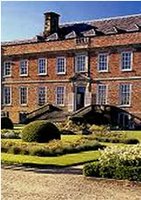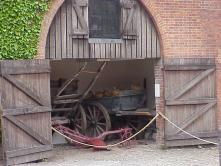
I blogged a few months ago about servants and mentioned then Erddig in North Wales, one of the most-visited National Trust properties. The Yorke family, the Squires of Erddig, while not overpaying their staff were certainly fond enough of them to commission portraits or photographs of them, and write (mediocre) poetry about them. 
What makes Erddig (pronounced Er-thick–it’s Welsh) unique is that all of the outbuildings, dairies, laundries, stables, dogyards etc., are intact and restored. You can see before and after photographs showing what an enormous, and daunting task this was for the National Trust, as mostof the buildings, including the house itself, were derelict. In his final months in the house the last squire camped out in the drawing room by candlelight, with bowls set out to catch the drips from the leaking roof.

The gardens and grounds are gorgeous–tulips, primroses and bluebells were in bloom, and there’s a lovely (and rare) eighteenth century walled garden. Rare historic varieties of fruit trees, espaliered against the brick walls, were also flowering.

As for the house, it’s crammed full of amazing furniture and artwork, but all very dark and oppressive. The Yorkes, a rather eccentric family, didn’t believe in throwing anything away, or unnecessary plumbing or electricity. One of the nicest rooms is the late eighteenth-century kitchen, well-lit, by tall, elegant windows, and with its original tiled floor–not much changed other than by the addition of two Victorian ranges. It was frustrating to see features of the house–like particular pieces of art–and not be able to see the details you know from photographs.
Final word: definitely worth a visit. You could spend hours exploring the gardens and grounds, and the restaurant does great food (excellent cakes and a good cup of tea). But buy a guidebook so you can really see what things should look like!

Gorgeous. We just don’t belong in this time, do we?
LOL, I feel the same way sometimes, then I remember indoor plumbing!
Putting this on my “visit someday” list–nearly as long as my TBR list!